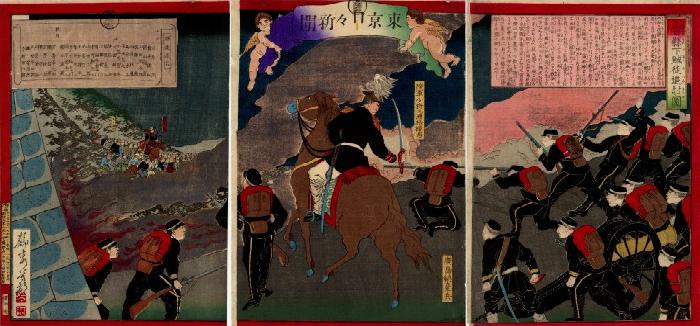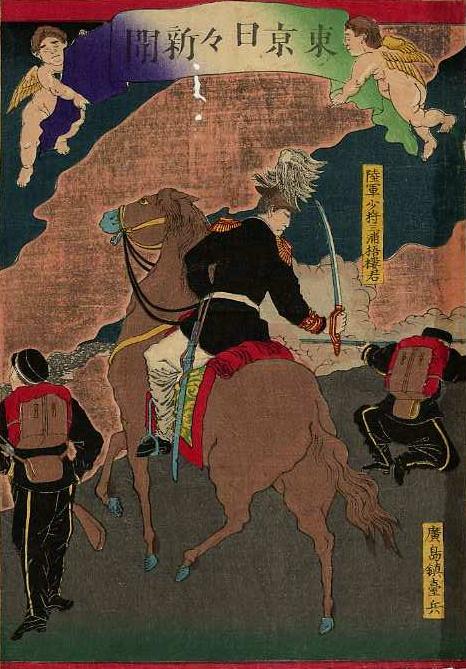Commentary
The Yamaguchi or Hagi rebellion (萩の乱 Hagi no ran) began on or about 28 October 1876 in Hagi, still the center of Choshu power in what had become Yamaguchi prefecture.
While Yoshitoshi's Yamaguchi rebels on run (YHS-1144) features the revolutionary Maebara Issei front and center, this triptych by Yoshimura shows the younger Miura Goro -- also a former Choshu samurai, but now an army general -- giving chase to Maebara's party of would-be insurgents. (WW)
Akizuki rebellion
Also unlike Yoshitoshi's single-sheet news nishikie, Yoshimura's triptych relates the Hagi rebellion to the Akizuki rebellion (秋月の乱 Akizuki no ran), which took place the day before in what is today Asakura city of Fukuoka prefecture.
The list of names of fallen "rebels" is broken down into two groups -- one "Yamaguchi" (山口), listing the supporters of Maebara Issei in Hagi in southwestern Honshu -- the other "Akizuki" (秋月), listing those who rallied around Miyazaki Shanosuke and others in Akizuki, across the Moji straits in Kyushu.
Akizuki was the name of a domain that became part of Fukuoka prefecture on Kyushu. Miyazaki Shanosuke (1835?-1876) and Iso Jun (1827?-1876) led a number of other disenfranchised samurai in a protest against the ban on carrying swords (which had been a privilege of the samurai caste), and against the conscription of commoners into the new army (as though ordinary people could perform the duties of samurai).
The Akizuki rebels also demanded, as had many others before them, including Saigo Takamori, that Japan send a military expedition to "chastise" Korea. Some 400 rebels are said to have fled to the mountains. Miyazaki, Iso, and other leaders killed themselves or were captured and executed by beheading -- the most severe form of capital punishment, and a dishonor for samurai, who might otherwise have been favored with an order (or allowed an opportunity) to execute themselves, as was possible under law until the Meiji period.
Note, in this regard, that Lord Asano, and later his 46-and-a-half ronin, did not commit suicide but executed themselves, as ordered, under authority of the laws that applied to their behaviors. The legal term -- and the term applied to what they did -- is "jisai" (自裁) or "self judgment".
Most of the eight Akizuki members on Yoshimura's list were among the seven -- including Miyazaki and a brother -- who performed "jiketsu" (自決) or "self decided" to die lieu of being captured and probably executed like commoners . Another brother, also on Yoshimura's list, was caught and decapitated. (WW)
Miura Goro
Miura Goro (1846-1926), like Maebara Issei (1834-1876), was a former Choshu samurai. He, though, became an army officer who continued to serve the cause of the imperial government well into the 20th century.
After the Satsuma/Choshu alliance established the Meiji government in 1868, Miura wasted no time joining the new army -- as did many former Choshu samurai, hence their dominance in Japanese army officer ranks for two or three generations.
Miura went on to distinguish himself in the Seinan War of 1877, triggered in part by a local revolt of the kind he suppressed in Yamaguchi. A viscount since 1884, he retired from the Army as a retired Lieutenant General, was Japan's Minister to Korea at the end of the Sino-Japanese war of 1894-1895.
While serving in Korea, Miura opposed the efforts of Empress Myongsong (Queen Min) of the Choson Dynasty to improve Korea's ties with Russia. Unable to deter her, he ordered some assassins to attack her palace on 8 October 1895. They killed three women they thought were the empress, confirmed that one was indeed her, and raped her corpse before finally burning her and dispersing her ashes (according to many reports).
The assassins were quickly whisked out of Korea. However, the incident was partly witnessed by Koreans, a Russian reporter, and an American military advisor at the palace. International criticism followed, and Japan recalled Miura and tried him, with 48 others, at a court in Hiroshima. He and the others were found not guilty for lack of evidence. (WW)
Who would have known
|
In May 2005 -- 110 years after Miura Goro's poachers bagged the "mad fox" as he had called Queen Min -- the son of a daughter of one of the queen's assassins, and a granddaughter-in-law of another, knelt before Myongsong's tomb in Hongnung, east of Seoul, and made tearful apologies -- before Korean cameras. Their visit to the peninsula was organized by a Korean journalist who has made a documentary about the descendants of the assassins. It will be shown on TV in August. (WW) |
Who would have known -- just looking at Yoshimura's nishikie portrait of the gallant Miura, barely thirty, sitting high in the saddle of his fine chestnut steed, his sword drawn, commanding his rifle squadron to fire on a motley mob of feebly armed rebels who dared to obstruct the new "civilization and enlightenment" government -- what he would be doing barely twenty years later.
Japan went on to defeat Russia in the Russo-Japanese War of 1904-1905, which resulted in Japan's control of Korea's diplomacy and other affairs. On 26 October 1909, Ito Hirobumi (1841-1909), another former Choshu samurai -- who in June had resigned as Japan's first Resident General of Korea, a post he had held since 1906, to become the head of the Sumitsuin (枢密院), the Emperor's advisory board, or Privy Council -- was shot down in Harbin, Manchuria by a Korean assassin whose name most Korean students can tell you, so I don't have to.
For his role in facilitating Japan's annexation of Korea in 1910, Miura Goro was given a seat on the Privy Council. Had either he or Ito lived long enough -- one wonders what sort of advice they would have given Hirohito. (WW)
Name list
The first six names on the Yamaguchi list are Maebara, Okudaira, Yokoyama, Yamada, Sase, and Shirai. Five of these men -- all but Sase -- figure in the story of their attempted escape by boat, depicted in Yoshitoshi's Yamaguchi rebels on run (YHS-1144).
Print information
Size oban triptych
Series: Tokyo nichinichi shinbun
Issue: No issue number (TNS-9005)
Notification date: 1876-11-22 (Stage 4 banner)
Drawer: Ito Seisai (signed Seisai Yoshimura)
Writer: Unsigned
Carver: Unsigned
Publisher: Fukuda Kumajiro [Gusokuya]
Price: 6 sen
Images: Tokyo University (Tsuchiya 2000), Yosha Bunko
Principal sources
Tsuchiya 2000
Yosha Bunko
CCMA 2008

